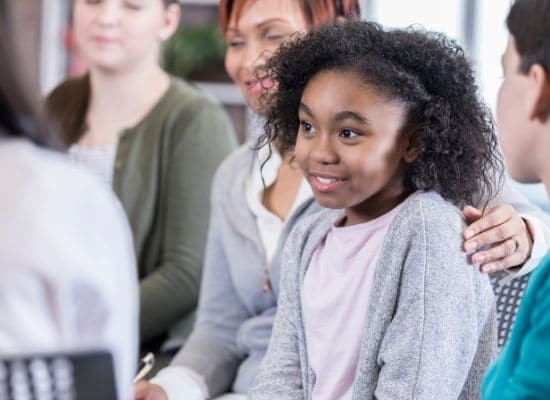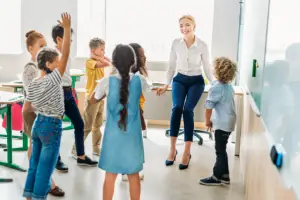Discipline in school settings has been a difficult issue to tackle for many years, usually swinging from one extreme to the other. Corporal punishment led to leniency and an inability to enforce discipline. Then zero tolerance policies tried to rein things back in, but with many casualties and not much success overall. But now there is a very promising way to tackle discipline, not only in the classroom, but in every school setting. And not only does this method solve many pernicious discipline problems, it helps to grow a healthy community filled with social emotionally healthy students and staff. And this is why schools need training in restorative practices.
Table of Contents
What are Restorative Practices?
The idea behind restorative practices is that, rather than punishing students and expecting students to adjust behavior out of fear of future punishment, students are guided through the process of recognizing the inappropriate behavior, thinking through appropriate solutions, and learning how to relate in healthy ways to others in the future.
This kind of training not only serves to make life better in the classroom, it also gives students and teachers excellent real-world skills that they will be able to use in every relationship they encounter throughout life. And this will help them to find greater success in the community, workplace, and social venues among many other places.
But the greatest outcome of restorative practices may actually be the communication skills that are learned and cultivated through this process, to students and staff alike. This is a lifelong skill that will be life-changing to those who learn its concepts.

How do Restorative Practices Benefit the Classroom?
So now that we know more about what restorative practices are, let’s take a look at how they benefit the school.
First, I would like to point out that the benefits are not just in the classroom. When implemented properly, restorative practices have great benefits from the school bus, to the classroom, to the playground, the gym, the cafeteria, and even the after school programs. Educating and training the whole school staff is critical in implementing restorative practices throughout the school experience.
Here are a few ways that restorative practices benefit the school:
- It teaches students how to relate to others and grow in community in healthy ways.
- It gives teachers an opportunity to be in better relationship with students.
- Disciplinary issues are better resolved.
Let’s take a closer look at each one of these points.
It teaches students how to relate to others and grow in community in healthy ways.
Teachers receive training that teaches them how to communicate effectively with other staff members, students, and parents. With these new communication skills, they are able to guide themselves and others into empathy and growth that will help everyone work through difficulty in working with problems in school and throughout all of life.

It Gives Teachers an Opportunity to be in Better Relationship With Students
When teachers are actively seeking out ways to hear and understand what their students, their parents, and fellow teachers, are saying, the people they are communicating will feel understood and appreciated. They will be more open in their communication, knowing that their words are important. And relationships will flourish with productive communication that yields great results. The difference, especially in the classroom, will be striking. Functionality, trust, and teamwork will be the norm.
Disciplinary issues are better resolved.
When issues arise in the classroom, restorative practices will allow those issues to be resolved with much less difficulty than traditional discipline techniques.
When there is a good working relationship between staff, students, and parents, everyone is listening and responding better. They are actively working together to the common good, knowing that everyone is being heard and acknowledged. And one of the biggest benefits of restorative practices is that everyone involved is generally open to finding a workable solution for all.
How do Schools Implement Restorative Practices?
Making the transition from traditional disciplinary policy to restorative practices can be daunting. But there are great ways to implement it in ways that are not so painful to school life. Here are some of the biggest things that can help make a smooth transition:
- Implement school-wide training.
- Follow up with regular reviews in staff meetings.
- Put a community board in the teachers’ areas.
- Make sure you have a full time RP Coordinator.
Now let’s take a look at each one of these principles in a bit more depth.

Implement School-wide Training
Training is critical to being able to ensure that the whole school is going in the right direction. Although it does require a bit of time up front, the investment is more than worth the time saved in putting out fires throughout the year without implementing the principles of Restorative Practices.
Training is a good time for teachers and staff to get on board with the concepts, get questions answered, and start practicing concepts before they go live in the classroom with it. They can get feedback from other teachers and staff. And, most importantly, they can get all of the information they need from professional trainers that know how the process works and can help them make the transition even smoother.
Follow up with regular review in staff meetings.
Once the restorative practices are implemented in your school, issues will come up from time to time that will need some extra attention. Being able to address these issues among other teachers or staff will strengthen the program immensely. Some teachers will have more experience and, therefore, more wisdom that will help teachers that are having issues find a way forward with those issues.
Using staff meetings as a venue for those discussions allows the staff to get the assistance they need without having to add more stress to the already burdened schedule that most teachers and staff already have.
Put a community board in the teachers’ areas.
This would be a perfect way to put up resources, suggestions, a question/answer area, and whatever else your school would find helpful to keep things running smooth school-wide.
It doesn’t have to be huge. And there are so many teachers and staff onsite that are already amazing at designing boards. This is such a natural way to make restorative principles a success for everyone. And it speaks nearly everyone’s language by using this resource.
Make sure you have a full time RP Coordinator.
This may be the most important of all of the implementation principles mentioned here. Having a staff member that is experienced in social emotional learning and restorative principles will be life-changing for your school.
They will be aware of the potential issues that arise out of establishing a new restorative principle program. They will understand how to deal with issues that are atypical. And they will know what specific things work and what ones don’t over time. That will save so much time in trying to figure everything out. There will be no need to reinvent the wheel here!
How SRPC Training Can Help Your School
Once schools are ready to transfer over to restorative principles, SRPC Training can help in many ways. Here are the most critical:
- SRPC (School Restorative Practices Coordinator) Training with Certificate
- Restorative Practices for Schools–Professional Development Training
- Staff Emotional Assistance Training
Let’s take a look at what each one of these programs can do for your school.
SRPC Training With Certificate
Participants are given an in-depth look at restorative practices and other social sciences that will equip them to go back to their school setting ready to develop, implement, and monitor a restorative practices program that will work perfectly for their school’s circumstances.
Restorative Practices for Schools–Professional Development Training
The name of this training is Think BIG & be SMART 4R students.™ It is a student-centered program that focuses on giving teachers the resources they need to develop positive relationships with ALL of their students. A positive teacher/student relationship is critical to a successful classroom.
When school teachers and staff take the necessary time to develop healthy relationships with other staff, students, and parents, problems will be greatly reduced, and the classroom/school experience will be a much more positive one.
And restorative discipline is always a preferred method over punitive techniques. With this training you will see nearly immediate striking differences in the life of your school.
Staff Emotional Assistance Training
This training is centered around mindfulness, restorative principles, and social emotional health. These tenets will help teachers and staff to stay grounded when faced with difficult situations.
This training will give all stakeholders in the school definite action steps to work through difficult issues and maintain self care and stress management principles. This will allow them to function in the school setting without bringing unnecessary stressors into the classroom or home.
Conclusion
Restorative Practices are critical for schools today. And there is great training available that will help your school to thrive by implementing into every department. Check out this video by Roy Burton in reference to his programs at SRPCTraining.org:
I am really excited to see this program implemented in schools across America. Tell me what you think about it or what your experience has been in the comments below!
If you liked this article, I think you will also love the following articles:
What is Inquiry-based Learning and Why Will Your Students Love It
Problem-based Learning: Boost Your Students’ Success in the Real World
The Madeline Hunter Lesson Plan: Should We Still Be Using It?





This is very much needed, especially after this past year. I have noticed many kids not being able to figure out their feelings and burst out in anger. I am so thankful to our teachers. They have so much on their plates right now.
I honestly have never heard of restorative practices before I read this. I do agree that this would be the better option.
A fascinating article. I had never heard of restorative practices but it seems almost like common sense and can only be beneficial to both staff and student.
Discipline in school settings is one of the hardest things to tackle but Japan does a good job of disciplining the kids. The most obvious manifestation of discipline is their school rules.
As a teacher, I agree with these Restorative practices in teaching and learning. It is an approach that encourages behavior that is supportive and respectful. It puts the students to be truly accountable for their behavior.
First time to hear about it, and I am glad that our dear teachers teach this in school.
I know this will help the kids and the teachers to have a strong relationship.
This is amazing and I can see that it can help a lot in school. Thank you for sharing!
Our schools and teachers are in need of so much help, this is a great resource for them. Thank yoU!
I am not familiar with this strategy. It sounds like a great tool to have to help with a variety of issues.
This is a whole new concept to me. But anything that would benefit the kids is something that is good!
All schools need to have restorative practices back in them as soon as possible. So many things have gone wrong that could have been prevented or stopped from happening, in the first place. It’s a great idea. I love it.
restorative practises are indeed very important. Thanks for sharing this post.